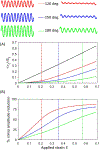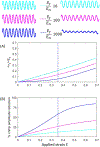Crimped fiber composites: mechanics of a finite-length crimped fiber embedded in a soft matrix
- PMID: 36862346
- PMCID: PMC10656043
- DOI: 10.1007/s10237-023-01702-9
Crimped fiber composites: mechanics of a finite-length crimped fiber embedded in a soft matrix
Abstract
Composites comprising crimped fibers of finite length embedded in a soft matrix have the potential to mimic the strain-hardening behavior of tissues containing fibrous collagen. Unlike continuous fiber composites, such chopped fiber composites would be flow-processable. Here, we study the fundamental mechanics of stress transfer between a single crimped fiber and the embedding matrix subjected to tensile strain. Finite element simulations show that fibers with large crimp amplitude and large relative modulus straighten significantly at small strain without bearing significant load. At large strain, they become taut and hence bear increasing load. Analogous to straight fiber composites, there is a region near the ends of each fiber which bears much lower stress than the midsection. We show that the stress-transfer mechanics can be captured by a shear lag model where the crimped fiber can be replaced with an equivalent straight fiber whose effective modulus is lower than that of the crimped fiber, but increases with applied strain. This allows estimating the modulus of a composite at low fiber fraction. The degree of strain hardening and the strain needed for strain hardening can be tuned by changing relative modulus of the fibers and the crimp geometry.
Keywords: Collagen recruitment; Crimped fiber; Fiber-reinforced composite; Strain hardening.
© 2023. The Author(s), under exclusive licence to Springer-Verlag GmbH Germany, part of Springer Nature.
Conflict of interest statement
Figures








References
-
- Chazeau L, Gauthier C, Vigier G, Cavaillé J, Chazeau L, Gauthier C, Vigier G, Relationships JC (2020) Relationships between microstructural aspects and mechanical properties in polymer based nanocomposites To cite this version: HAL Id : hal-02917761 Please cite as: Relationships between microstructural aspects and mechanical properties in polymer based.
-
- Cox HL (1952) The elasticity and strength of paper and other fibrous materials. Br J Appl Phys 3(3):72–79. 10.1088/0508-3443/3/3/302 - DOI
MeSH terms
Substances
Grants and funding
LinkOut - more resources
Full Text Sources

